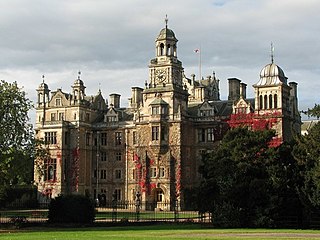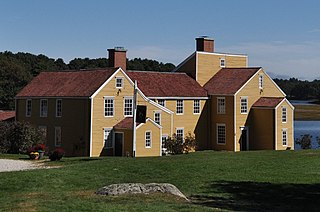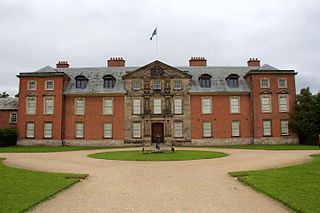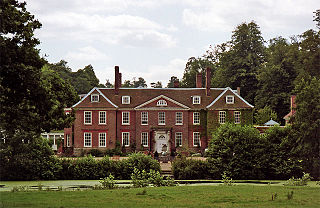
Sir Charles BarryFRS RA was a British architect, best known for his role in the rebuilding of the Palace of Westminster in London during the mid-19th century, but also responsible for numerous other buildings and gardens. He is known for his major contribution to the use of Italianate architecture in Britain, especially the use of the Palazzo as basis for the design of country houses, city mansions and public buildings. He also developed the Italian Renaissance garden style for the many gardens he designed around country houses.

Lyme Park is a large estate south of Disley, Cheshire, England, managed by the National Trust and consisting of a mansion house surrounded by formal gardens and a deer park in the Peak District National Park. The house is the largest in Cheshire, and is recorded in the National Heritage List for England as a designated Grade I listed building.

Ightham Mote, at Ightham, is a medieval moated manor house in Kent, England. The architectural writer John Newman describes it as "the most complete small medieval manor house in the county".

Giacomo Leoni, also known as James Leoni, was an Italian architect, born in Venice. He was a devotee of the work of Florentine Renaissance architect Leon Battista Alberti, who had also been an inspiration for Andrea Palladio. Leoni thus served as a prominent exponent of Palladianism in English architecture, beginning in earnest around 1720. Also loosely referred to as Georgian, this style is rooted in Italian Renaissance architecture.

Woolley Hall is a country house in Woolley, West Yorkshire, England. It is a Grade II* listed building.

Beaupré Hall was a large 16th-century house mainly of brick, which was built by the Beaupres in Outwell, Norfolk, England and enlarged by their successors the Bells. Like many of Britain's country houses it was demolished in the mid-20th century.

Ingatestone Hall is a Grade I listed 16th-century manor house in Essex, England. It is located outside the village of Ingatestone, approximately 5 miles (8.0 km) south west of Chelmsford and 25 miles (40 km) north east of London. The house was built by Sir William Petre, and his descendants live in the house to this day. Part of the house is leased out as offices while the current Lord Petre's son and heir apparent lives in a private wing with his family. The Hall formerly housed Tudor monarchs such as Queen Elizabeth I.

Matthew Brettingham, sometimes called Matthew Brettingham the Elder, was an 18th-century Englishman who rose from modest origins to supervise the construction of Holkham Hall, and become one of the best-known architects of his generation. Much of his principal work has since been demolished, particularly his work in London, where he revolutionised the design of the grand townhouse. As a result, he is often overlooked today, remembered principally for his Palladian remodelling of numerous country houses, many of them situated in the East Anglia area of Britain. As Brettingham neared the pinnacle of his career, Palladianism began to fall out of fashion and neoclassicism was introduced, championed by the young Robert Adam.

Hornby Castle is a country house, developed from a medieval castle, standing to the east of the village of Hornby in the Lune Valley, Lancashire, England. It occupies a position overlooking the village in a curve of the River Wenning. The house is recorded in the National Heritage List for England as a designated Grade I listed building.

Thoresby Hall is a grade I listed 19th-century country house in Budby, Nottinghamshire, some 2 miles (4 km) north of Ollerton. It is one of four neighbouring country houses and estates in the Dukeries in north Nottinghamshire all occupied by dukes at one time during their history. The hall is constructed of rock-faced ashlar with ashlar dressings. It is built in four storeys with a square floor plan surrounding a central courtyard, nine bays wide and eight bays deep.
Wentworth Castle is a grade-I listed country house, the former seat of the Earls of Strafford, at Stainborough, near Barnsley in South Yorkshire, England. It is now home to the Northern College for Residential and Community Education.

Wentworth–Coolidge Mansion is a 40-room clapboard house which was built as the home, offices and working farm of colonial Governor Benning Wentworth of New Hampshire. It is located on the water at 375 Little Harbor Road, about two miles southeast of the center of Portsmouth. It is one of the few royal governors' residences to survive almost unchanged. The site is a New Hampshire state park, declared a National Historic Landmark in 1968. Today, the New Hampshire Bureau of Historic Sites manages the site with the assistance of the Wentworth-Coolidge Commission, a group of volunteer civic and business leaders appointed by the Governor.

Dunham Massey Hall, usually known simply as Dunham Massey, is an English country house in the parish of Dunham Massey in the district of Trafford, near Altrincham, Greater Manchester. During World War I it was temporarily used as the Stamford Military Hospital.

Gosfield is a village in the Braintree district of Essex, England. It is located around two miles west of the town of Halstead.

Chilston Park is a country house in Boughton Malherbe, Kent, England. Started in the 15th century, the house has been modified many times and is a Grade I listed building, currently operated as a country house hotel.

Sir John Deane of Dyne's Hall in the parish of Great Maplestead in Essex, was an English politician who sat in the House of Commons from 1621 to 1622.

Strangers' Hall is a Grade I listed building and museum of domestic history located in Norwich, UK. Throughout its 700-year history, Strangers' Hall has been the home to numerous Mayors of Norwich and has served both domestic and commercial functions. A courtyard house, the oldest part of the building is the 14th-century undercroft while further additions were made through to the 17th century by various merchants and mayors, most notably the Sotherton family, Francis Cock and Joseph Paine. The house ended up in the hands of the Roman Catholic church before being bought by Leonard Bolingbroke, who converted it into a folk museum at the start of the 20th century. He then gave the house to the city of Norwich, which has since run it as a museum of domestic history. Although other theories have been proposed regarding the origins of the name of the house, it is named after the Strangers, a group of Protestant refugees seeking political asylum from the Catholic Low Countries from 1565, some of whom lived in the hall.
John Wentworth (1564–1613), of Gosfield Hall, Essex, was an English politician.

Coleshill House was a country house in England, near the village of Coleshill, in the Vale of White Horse. Historically, the house was in Berkshire but since boundary changes in 1974 its site is in Oxfordshire.
Sir John Wentworth, 1st Baronet, of Gosfield, Essex, was an English aristocrat.



















